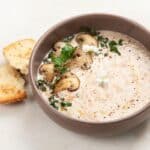In short, the best alternatives to chicken broth include chicken stock, beef broth, vegetable stock, mushroom broth, bouillon cubes, etc. I will explain how to use each substitute and offers suggestions for when they are most appropriate.
Chicken broth is a fantastic versatile ingredient. When you need to add liquid to a savory recipe it will bring more depth than water, yet won’t overpower the other flavors in your dish. Additionally, it can be used as-is in a chicken noodle bowl or with dumplings.
There’s only one small setback – good things take time, and that applies to the chicken broth as well. Making this savory liquid from scratch is not an instant solution when you need something immediately for a stew, sauce, or soup. It is also not a suitable option for vegetarian meals.
Luckily, there are a number of much quicker alternatives available. So, when you’re in a pinch, choose one of the below chicken broth substitutes as a quick fix. There’s likely to be something you already have in the pantry, just waiting on stand-by.
Stock vs Broth: The Differences
Before we get into the list of possible chicken broth substitutes, it is worth noting that, even though people use the terms interchangeably, chicken broth and chicken stock are not exactly the same thing.
Stock is made by simmering bones and cartilage for six to eight hours. The process does not involve any meat.
Cooking down the bones helps with the extraction of gelatin and collagen. This gives the stock a thicker consistency which is intended to contribute to the texture or mouthfeel of a sauce or soup, rather than pack a punch of flavor.
Stock can be made from chicken, fish, or beef bones and serves as a good base from which to build flavors in your dish.
It is generally left unseasoned so as to enhance but not interfere with the flavor profiles of the cuisine you are cooking. This makes it very versatile to use in almost any type of cuisine.
Broth, on the other hand, refers to simmering meat in water. This can be done with or without the bones. The cooking process is much quicker to prevent the meat from overcooking.
When making homemade chicken broth, you can remove the chicken meat as soon as it is cooked and continue to reduce the liquid for a deeper flavor. The meat can either be added back at the end of cooking time or used for a completely different dish.
Since broth is also commonly eaten as a clear, light soup it can be seasoned with herbs, vegetables, spices, or other seasonings.
To keep the liquid clear, egg whites are sometimes added during cooking. As the egg whites coagulate, they trap any particles that turn the liquid murky. Once the whites are strained, the broth should be lighter and transparent without losing any flavor.
When To Use Stock vs Broth
Since broth and stock are both savory liquids with similar properties, they can be used interchangeably as a base for sauces, soups, stew, and gravy. However, unlike stock, broth is also used on its own as a light soup or ladled over noodles.
Broth is best used in dishes where you need flavor immediately. For example, if you are using the liquid as a soup, broth will already be rich in flavor and won’t require too many additions.
On the other hand, if you are making curry or stew and still adding lots of other spices and ingredients, the stock will make an ideal blank canvas to enrich the other flavors in your recipe.
Broth is often used to cook risotto, grains, legumes, and dumplings. It is also used in gravies, cream sauces, sauteed dishes, stuffing, and soup.
Bouillon vs Consommé vs Bone Broth
Other terms used interchangeably with broth are consommé, bouillon, and bone broth.
Bouillon is simply the French term used for broth. Bouillon cubes are dehydrated broth in the form of cubes that can be rehydrated in water for an instant solution, almost like a soup powder.
Consommé is simply clear and clarified broth. It is mostly used as a light soup with a good depth of flavor.
Bone broth is technically a stock since it is made by cooking down beef or chicken bones for 24 hours to extract the collagen. It sometimes contains an acidic component to facilitate connective tissue breakdown and may contain other seasonings.
Bone broth is consumed for its health benefits as a warm drink or soup but can also be used in other cooking.
What Can I Substitute for Chicken Broth?
#1. Chicken Stock
As already discussed, chicken stock can be used interchangeably with broth in equal quantities. It may have a slightly thicker consistency and less pronounced taste, but you can easily adjust this.
For a richer flavor add a pinch of salt, extra spices, or seasonings to taste. If you find it too thick, dilute it with a bit of water. Stock will, however, impart very similar flavor undertones to your dish.
#2. Beef Broth
Beef broth is made in the same way as the chicken version, except using beef. The meat is cooked with or without the bones with the addition of vegetables and herbs.
It has a great full-bodied depth of flavor and is generally more pronounced than chicken or vegetable broth. You can use a homemade or store-bought type in equal quantities as a substitute.
Related: What can I use instead of beef broth?
#3. Vegetable Stock
If you are looking for a vegan alternative, this is a perfect choice. Surprisingly, vegetable stock is very flavorful and offers the same consistency.
It is usually made by simmering onions, carrots, garlic, and celery and then straining out the cooked vegetables. Mushrooms and other vegetables can also be included with some fresh herbs, dried herbs, or other seasonings.
Use your leftover vegetable scraps to make your own homemade broth by sauteing the vegetable cut-offs in a pot. Add water and seasoning and let it simmer for a few hours. Once cooked to the desired intensity, strain the mixture through a cheesecloth to get a clearer liquid.
Beef, chicken, and vegetable broth can all be frozen, so feel free to make large batches and freeze them so you don’t run out.
#4. Mushroom Broth
Mushrooms have a deep earthy taste which makes this a wonderful full-bodied substitute that is vegan-friendly. This is especially delicious when making risotto and sauces.
To make it at home, simmer chopped onions, mushrooms, and celery for up to an hour and strain the cooked mixture through cheesecloth the same way you would vegetable broth. Optionally add some garlic, bay leaves, and season to taste with salt and pepper.
#5. Chicken Bouillon Cubes
The great thing about bouillon cubes is that they have a long shelf life in the pantry so you can always keep them on hand as a quick fix. Essentially, they are a dehydrated form of stock, compressed into a cube.
Dissolve the cube in boiling water as per the instructions on the packaging and you’re ready to cook. Replace the reconstituted liquid measure for measure.
Note that the cubes are usually on the salty side, so make sure to taste and adjust other seasonings if necessary. The cubes are available in a wide variety of flavors including chicken, beef, fish, vegetable, low-sodium, and gluten-free.
#6. Bouillon Granules
Bouillon granules are the same as the cubes except that they are not pressed into cubes and are therefore easier to use in a small amount. As with the cubes, dissolve the granules in water according to the package instructions and replace the reconstituted solution in equal quantities.
#7. Chicken Broth Paste
Similar to cubes and granules, this is a chicken broth concentrate, but it comes in a paste form. The paste comes in a small jar and needs to be refrigerated after opening.
Since the paste is quite strong, you can start by dissolving half a teaspoon of paste in one cup of hot water. Brands may be different so check the label to be sure about the ratio of paste to water. Substitute the diluted solution cup for cup.
#8. Ramen Noodle Seasoning
If you happen to have a packet of instant chicken ramen noodles (or even a vegetable or mushroom flavor will do) in the cupboard, you can use the seasoning sachet as a makeshift substitute.
Flavors like bacon, seafood, or cheese will change the taste of your dish since they are quite strong and have an artificial taste. Stick with something that is fairly neutral in its flavor profile. Mix the seasoning packet with one cup of hot water until well dissolved.
One thing about these little packets of seasoning is that they are very salty, so always taste them before you add them to the other ingredients. Dilute it further if it’s too strong. Once you have the desired strength, replace it in equal measures.
#9. White Wine
If your recipe calls for half a cup or less of broth, dry white wine can make a suitable substitute. This will add a little more acidity to your dish and can change the taste in delicately flavored dishes slightly.
Mix the wine with an equal amount of water and replace the diluted solution in equal quantities. Keep in mind that you need to cook out the alcohol, so make sure there is enough cooking time.
We don’t recommend using wine as a substitute in soups or in dishes where the broth is used on its own (such as ladled over dumplings or noodles). However, it can be a great substitute in long-cooking stews, sauces, and casseroles that integrate a variety of other ingredients.
Related: White wine replacement
#10. Butter and Water
As with the above option, this is not suitable as a substitute in soups or on its own, but can be successful in stews or casseroles. Salted butter will add a bit of saltiness, but if you only have unsalted at home, simply add a pinch of salt to the mixture.
Although it won’t provide the chicken flavor, it will add richness, depth, and savoriness. Melt one tablespoon of salted butter into a cup of hot water to replace one cup of broth.
#11. Court Bouillon
This is a quick-cooking broth (also known as short broth) that doesn’t contain animal products. It is made with water, the acid in the form of wine, citrus, or vinegar, and either vegetables or seasonings.
It is used to poach fish, delicate meat, eggs, or sweetbreads. Use this option in equal quantities as a replacement in stews, casseroles, and stir fry.
#12. Aquafaba
If you have a can of chickpeas in the pantry you can use the chickpea liquid drained from the can as a suitable substitute. If you generally use only the chickpeas, don’t be so quick to toss the remaining liquid (aquafaba).
Since the starch from the chickpeas gets absorbed into the liquid (which gives it its slightly thick consistency) it can be suitably used as a liquid or as a binding agent. Some people use it as a vegan substitute for eggs and it can even be whipped into a foam (similar to egg whites).
Dilute the aquafaba with an equal amount of water and then replace it in equal quantities. It is best used in heavier sauces or stews since it has a thicker consistency.
#13. Dashi
Although you will likely not find dashi at your local grocery store, you may have it on hand if you do a lot of Asian cooking. Essentially a Japanese-style broth, dashi is made from cold-brewing kombu. There are also stronger versions that are made from dried mushrooms, dried shrimp or scallops, and toasted soybeans.
This option will add a great depth of flavor to your dish. Dashi can easily overpower other flavors in delicate recipes, so start with a small amount and add to taste.
#14. Coconut Milk
Coconut has a different taste and a much creamier profile but can work as a good substitute in some African dishes and curries. It’s a good vegan option, just make sure the coconut taste pairs well with the other flavors in your dish.
Related: Can cream of coconut be substituted for coconut milk?
FAQs
Conclusion
Making your own broth at home is a time-consuming process. If you need a chicken broth substitute at the drop of a hat, there are luckily a few options to choose from.
Since many replacements contain a high amount of salt, it’s important to taste as you go. If the replacement is a little too salty, adjust other seasonings in your dish, or dilute it with water to maintain the balance. Happy cooking!
Up next: How long does open chicken broth last?
*image by magone/depositphotos









